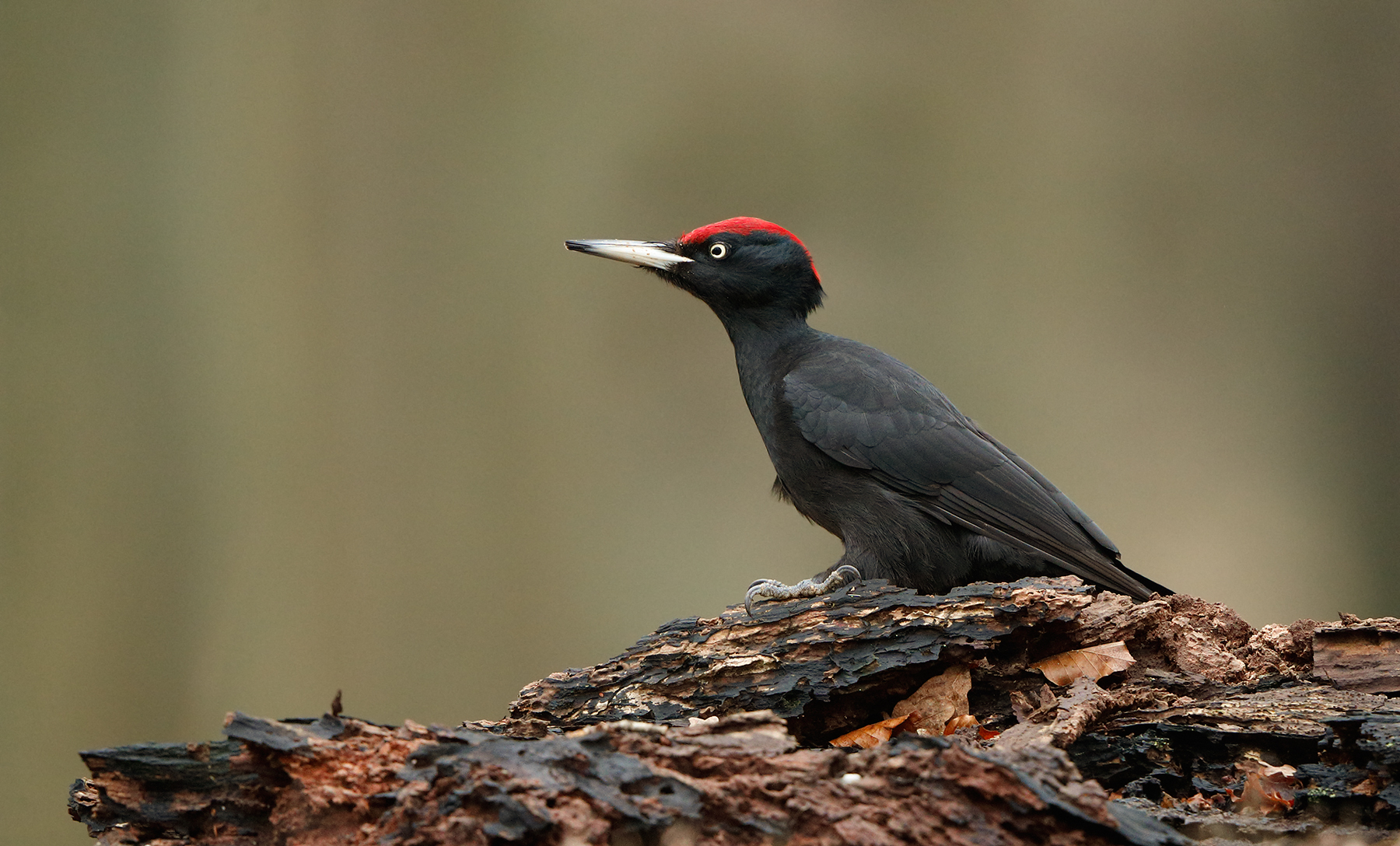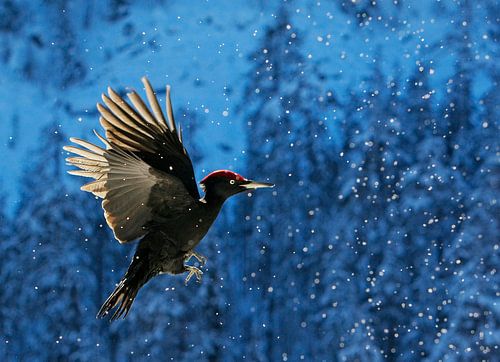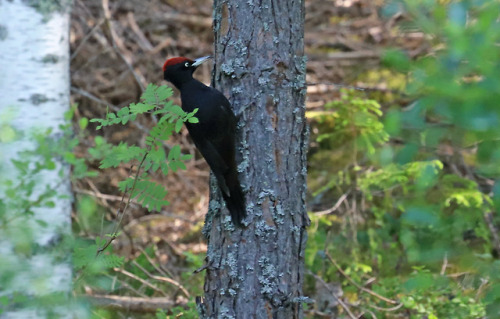
Range
The range of the black woodpecker spreads east from Spain across the whole of Europe, excluding Ireland, the United Kingdom and northern Scandinavia. It is also native to parts of Asia, including Korea, Japan and China, and to the Middle East, including Iran and Kazakhstan. The southern limits of this woodpecker's range are in Spain and Italy, and it has also been recorded as a vagrant in Portugal. The species is generally more uncommon and more discontinuous in distribution in the Asian part of its range.[2]Description

wingspan.[3][4][5] Body weight is approximately 250 to 400 g (8.8 to 14.1 oz) on average.[5][6][7][8] Among standard measurements, the wing chord is 22.7 to 26 cm (8.9 to 10.2 in), the tail is 15.9 to 17.3 cm (6.3 to 6.8 in), the very long bill is 5 to 6.7 cm (2.0 to 2.6 in) and the tarsus is 3.6 to 4 cm (1.4 to 1.6 in).[5] It is easily the largest woodpecker in its range and is second in size only to the great slaty woodpecker amongst the woodpecker species certain to exist, although its average mass is similar to that of the Magellanic woodpecker of South America. The closely related pileated and white-bellied woodpeckers also broadly overlap in size with the black woodpecker, but both are somewhat smaller in average and maximal size and mass.[5][9] The plumage of this crow-sized woodpecker is entirely black apart from a red crown. In males, the entire crown is red, but in females only the top hindcrown is red with the rest of the body all black.[3] The juvenile black woodpecker is similar but is less glossy, with a duller red crown and a paler grey throat and bill .[10] The piercing yellow eyes and manic, high-pitched calls of the black woodpecker have made it the villain of fairy tales throughout its range. Their voice is remarkable in that it has two different calls. One is a short single high-pitched note, a loud, whistling kree-kree-kree, done only twice in a row. The other is a screech-like shrill while in flight. Unlike other woodpecker species, the black woodpecker does not have a dipping, bounding flight but instead flies with slow, unsteady-seeming wing beats with its head raised.[5][10]
Habitat

The black woodpecker is mainly found in forested regions, with a preference for extensive, mature woodland, including coniferous, tropical, subtropical and boreal forests. It is very widespread throughout mountainous and lowland forests. It is more likely to occur in marginal woods near human habitations during the non-breeding season. This species has been observed at elevations between 100 and 2,400 m (330 and 7,870 ft).[2][5][10]
Behaviour
Tree work by black woodpecker
Egg, Collection Museum Wiesbaden
When the nest is ready, the female lays a single clutch of two to eight eggs, the average being four to six. The nest hole is usually dug in a live poplar or pine tree.[11] The breeding pair take it in turns to incubate the eggs, also sharing duties of feeding and brooding the chicks once they have hatched. The nestlings may fight their way to the entrance of the nest in order to be fed first. After 18 to 35 days the young black woodpecker will leave the nest, staying with the adults for another week.[5][10]
Mortality and status
The black woodpecker is a fairly widely distributed woodland species and can successfully breed in most areas where extensive woodland is left. At one point, when much of Europe and Asia was deforested, this species declined and in some areas are still struggling today, including the Pyrenees. They normally require mature trees and ample stands of dead trees to be to have a viable breeding population.[14] However, with the restoration of some forested areas, black woodpeckers have increased in some parts of Europe.[12] They are occasionally considered a nuisance species due to their damage to power lines and communication poles and to house, occasionally resulting in woodpecker mortality due to electrocution or being culled by humans.[15] The main cause of nesting failures appears to be predation.[16] Their main natural predator is the pine marten (Martes martes), which feeds on eggs, nestlings and brooding females and then often takes over the nest hole of the woodpecker for its own.[17] Other than the marten, there are notably few known natural predators of black woodpeckers.[18] Western jackdaws (Corvus monedula) are notably regular usurpers of this species nest holes and a potential predator of eggs and small nestlings.[19] A few of the larger birds of prey that can hunt in woodlands may prey on black woodpeckers. Among those recorded are Ural owls (Strix uralensis),[20] Eurasian eagle-owls (Bubo bubo),[21] northern goshawk (Accipiter gentilis),[22] common buzzards (Buteo buteo)[23] and golden eagles (Aquila chrysaetos).

Dryocopus martius

Black woodpecker range




No comments:
Post a Comment
Note: Only a member of this blog may post a comment.